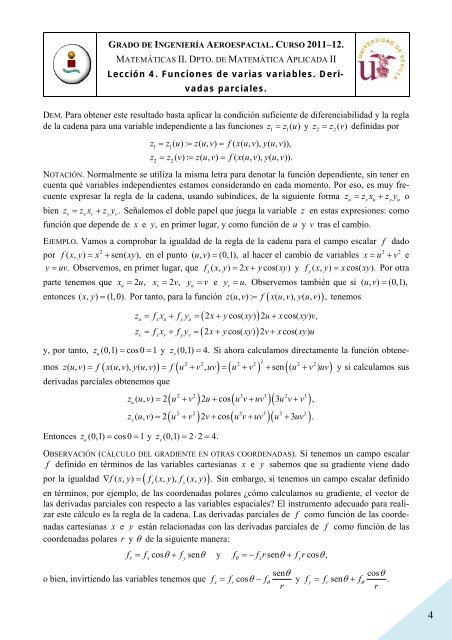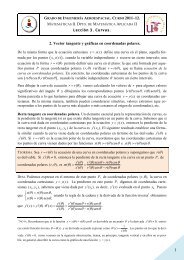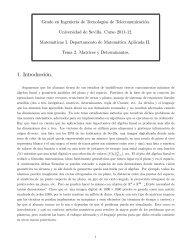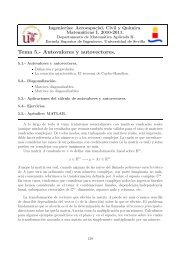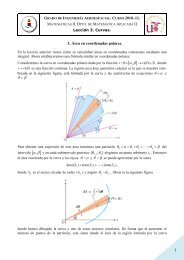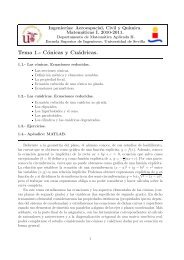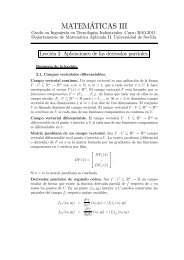Leccion 4. 4. Las reglas de la cadena - Matemática Aplicada II
Leccion 4. 4. Las reglas de la cadena - Matemática Aplicada II
Leccion 4. 4. Las reglas de la cadena - Matemática Aplicada II
Create successful ePaper yourself
Turn your PDF publications into a flip-book with our unique Google optimized e-Paper software.
GRADO DE INGENIERÍA AEROESPACIAL. CURSO 2011–12.<br />
MATEMÁTICAS <strong>II</strong>. DPTO. DE MATEMÁTICA APLICADA <strong>II</strong><br />
Lección <strong>4.</strong> Funciones <strong>de</strong> varias variables. Derivadas<br />
parciales.<br />
DEM. Para obtener este resultado basta aplicar <strong>la</strong> condición suficiente <strong>de</strong> diferenciabilidad y <strong>la</strong> reg<strong>la</strong><br />
<strong>de</strong> <strong>la</strong> ca<strong>de</strong>na para una variable in<strong>de</strong>pendiente a <strong>la</strong>s funciones z1 = z1 ( u)<br />
y 2 2 () z = z v <strong>de</strong>finidas por<br />
z1 = z1( u): = zuv ( , ) = f( xuv ( , ), yuv ( , )),<br />
z = z( v): = zuv ( , ) = f( xuv ( , ), yuv ( , )).<br />
2 2<br />
NOTACIÓN. Normalmente se utiliza <strong>la</strong> misma letra para <strong>de</strong>notar <strong>la</strong> función <strong>de</strong>pendiente, sin tener en<br />
cuenta qué variables in<strong>de</strong>pendientes estamos consi<strong>de</strong>rando en cada momento. Por eso, es muy frecuente<br />
expresar <strong>la</strong> reg<strong>la</strong> <strong>de</strong> <strong>la</strong> ca<strong>de</strong>na, usando subíndices, <strong>de</strong> <strong>la</strong> siguiente forma zu = zxxu + zyyu o<br />
bien zv = zxxv + zyyv. Señalemos el doble papel que juega <strong>la</strong> variable z en estas expresiones: como<br />
función que <strong>de</strong>pen<strong>de</strong> <strong>de</strong> x e y , en primer lugar, y como función <strong>de</strong> u y v tras el cambio.<br />
EJEMPLO. Vamos a comprobar <strong>la</strong> igualdad <strong>de</strong> <strong>la</strong> reg<strong>la</strong> <strong>de</strong> <strong>la</strong> ca<strong>de</strong>na para el campo esca<strong>la</strong>r f dado<br />
2<br />
2 2<br />
por f ( xy , ) = x + sen( xy),<br />
en el punto ( uv , ) = (0,1), al hacer el cambio <strong>de</strong> variables x = u + v e<br />
y = uv.<br />
Observemos, en primer lugar, que fx ( xy , ) = 2x+ ycos( xy)<br />
y f y ( xy , ) = xcos( xy).<br />
Por otra<br />
parte tenemos que xu = 2 u,<br />
xv = 2, v yu = v e yv = u.<br />
Observemos también que si ( uv , ) = (0,1),<br />
entonces ( , ) (1,0).<br />
zuv ( , ): = f xuv ( , ), yuv ( , ) , tenemos<br />
xy= Por tanto, para <strong>la</strong> función ( )<br />
( )<br />
( )<br />
zu = fxxu + fyyu = 2x+ ycos( xy) 2u+ xcos( xy) v,<br />
z = f x + f y = 2x+ ycos( xy) 2v+ xcos( xy) u<br />
v x v y v<br />
y, por tanto, z u (0,1) = cos 0 = 1 y z v (0,1) = <strong>4.</strong> Si ahora calcu<strong>la</strong>mos directamente <strong>la</strong> función obtene-<br />
2 2 2 2<br />
2<br />
2 2<br />
mos z( u, v) f ( x( u, v), y( u, v) ) f ( u v , uv) ( u v ) sen ( ( u v ) uv)<br />
= = + = + + + y si calcu<strong>la</strong>mos sus<br />
<strong>de</strong>rivadas parciales obtenemos que<br />
( 2 2) ( 3 3)( 2 3)<br />
( 2 2) ( 3 3)( 3 2)<br />
z ( u, v) = 2 u + v 2u+ cos u v+ uv 3 u v+ v ,<br />
u<br />
z ( u, v) = 2 u + v 2v+ cos u v+ uv u + 3 uv .<br />
Entonces z u (0,1) = cos 0 = 1 y z v (0,1) = 2⋅ 2 = <strong>4.</strong><br />
v<br />
OBSERVACIÓN (CÁLCULO DEL GRADIENTE EN OTRAS COORDENADAS). Si tenemos un campo esca<strong>la</strong>r<br />
f <strong>de</strong>finido en términos <strong>de</strong> <strong>la</strong>s variables cartesianas x e y sabemos que su gradiente viene dado<br />
por <strong>la</strong> igualdad f xy ( fx xy fy xy)<br />
∇ ( , ) = ( , ), ( , ) . Sin embargo, si tenemos un campo esca<strong>la</strong>r <strong>de</strong>finido<br />
en términos, por ejemplo, <strong>de</strong> <strong>la</strong>s coor<strong>de</strong>nadas po<strong>la</strong>res ¿cómo calcu<strong>la</strong>mos su gradiente, el vector <strong>de</strong><br />
<strong>la</strong>s <strong>de</strong>rivadas parciales con respecto a <strong>la</strong>s variables espaciales? El instrumento a<strong>de</strong>cuado para realizar<br />
este cálculo es <strong>la</strong> reg<strong>la</strong> <strong>de</strong> <strong>la</strong> ca<strong>de</strong>na. <strong>Las</strong> <strong>de</strong>rivadas parciales <strong>de</strong> f como función <strong>de</strong> <strong>la</strong>s coor<strong>de</strong>nadas<br />
cartesianas x e y están re<strong>la</strong>cionadas con <strong>la</strong>s <strong>de</strong>rivadas parciales <strong>de</strong> f como función <strong>de</strong> <strong>la</strong>s<br />
coor<strong>de</strong>nadas po<strong>la</strong>res r y θ <strong>de</strong> <strong>la</strong> siguiente manera:<br />
f = f cosθ + f senθ<br />
y fθ= − f rsenθ + f rcos<br />
θ ,<br />
r x y<br />
o bien, invirtiendo <strong>la</strong>s variables tenemos que<br />
x y<br />
senθ<br />
fx = fr cosθ<br />
− fθ<br />
y<br />
r<br />
cosθ<br />
fy = frsen θ +<br />
fθ<br />
.<br />
r<br />
4


